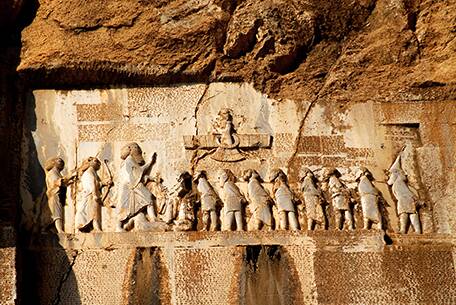Do you long to explore the rich heritage of the ancient Persian Empire? If so, then a visit to Bisotun in Kermanshah, Iran is an absolute must. This remarkable site boasts a large rock relief and inscription that offer an incredible glimpse into the history and culture of the Achaemenid Empire, one of the most powerful and influential empires of the ancient world.
But what truly sets Bisotun apart is the fact that the carvings and inscriptions on the steep mountainside are over 2,500 years old, yet they remain incredibly well-preserved. The impressive engineering and artistic skills of the ancient Persians are on full display at Bisotun, making it a must-visit destination for anyone fascinated by ancient history and culture.
To visit Bisotun, don’t hesitate to look into our Iran World Heritage Tour.

History of Bisotun
Bisotun is located on a steep mountainside, and is named after the nearby Bisotun village. The site is known for the large rock relief that is carved into the side of the mountain, which depicts a scene from the reign of Darius the Great, one of the most powerful rulers of the Achaemenid Empire.
The relief shows Darius standing on a platform, with his foot on the chest of a defeated enemy. Behind him, nine prisoners are shown in chains, with their hands tied behind their backs. The inscription that accompanies the relief is written in three languages: Old Persian, Elamite, and Babylonian, and describes the events leading up to Darius’s ascension to the throne, as well as his victory over the rebels who challenged his rule.

Why is Bisotun in Iran recognized as a UNESCO world heritage?
Bisotun is an important site for a number of reasons.
- Firstly, it provides valuable insight into the history and culture of the Achaemenid Empire, which was one of the most powerful and influential empires of the ancient world. The relief and inscription at Bisotun provide a detailed account of the events surrounding Darius’s rise to power, as well as his successful campaign against the rebels who challenged his rule.
- Secondly, Bisotun is significant because it is a testament to the advanced engineering and artistic skills of the ancient Persians. The relief at Bisotun is carved into the side of a steep mountain and required an incredible amount of skill and precision to create. The inscription is also a remarkable feat of engineering, as it is carved into the rock face at a height of over 100 feet.
- Finally, Bisotun is significant because it is a symbol of the resilience and strength of the Iranian people. The site has survived for over 2,500 years, and despite the ravages of time and weather, the relief and inscription at Bisotun continue to inspire and fascinate visitors from around the world.

When to visit Bisotun?
The best time to visit Bisotun in Kermanshah, Iran is during the spring (March to May) or fall (September to November) when the weather is mild and pleasant. During these seasons, the temperatures are comfortable, and there is usually less rainfall, making it easier to explore the site and the surrounding area.

Where is Bisotun inscription located?
If you’re planning a trip to Iran, a visit to Bisotun is highly recommended. The site is easily accessible from the nearby town of Kermanshah, and can be reached by car or public transportation.
Visitors to Bisotun can explore the rock relief and inscription, and learn about the history and culture of the Achaemenid Empire. The site is also surrounded by beautiful natural scenery, with stunning views of the mountains and valleys that surround the site.
What to visit in Iran after Bisotun?
We have included Bisotun in Iran World Heritage Tour. This package offers a unique opportunity to explore the rich cultural and historical heritage of the region, including the stunning World Heritage monuments. Our tour packages offer a comprehensive and immersive experience of Iran’s diverse culture, architecture and nature at reasonable rates.
If you’re interested in exploring more of Iran’s cultural and historical treasures, there are many other destinations worth visiting. Here are a few suggestions:
Kermanshah: The province where Bisotun is also located there, has great potential to visit. Taq-e Bostan, Anahita Temple, Moaven al-Molk Tekyeh.
Persepolis: Located in the southwestern province of Fars, Persepolis is an ancient city that was once the capital of the Achaemenid Empire. The city is home to stunning ruins, including the Gate of All Nations, the Apadana Palace, and the Hall of 100 Columns.
Isfahan: Known as the “half of the world,” Isfahan is a beautiful city with a rich history and stunning architecture. Highlights include the Naqsh-e Jahan Square, the Chehel Sotoun Palace, and the Shah Mosque.
Shiraz: Located in the southern province of Fars, Shiraz is known for its beautiful gardens, historic mosques, and vibrant bazaars. Highlights include the gardens of Eram and Narenjestan, the Vakil Mosque, and the Nasir al-Mulk Mosque.
Ahvaz: Located in the southwestern province of Khuzestan, Ahvaz is a city known for its rich history and culture. Highlights include the Shush, Shushtar Historical Hydraulic System, and the ancient Elamite complex of Chogha Zanbil.
Golestan Palace: Located in Tehran, the Golestan Palace is a stunning example of Persian architecture and design, with beautiful gardens, intricate tilework, and ornate buildings and structures.
Let us know your experiences of visiting or your questions about Bisotun in the comment box below, we will be happy to hear from you!


















